Analysis of Innovation Design, Development, and Tesco's Strategies
VerifiedAdded on 2023/01/12
|9
|2652
|95
Report
AI Summary
This report provides a comprehensive analysis of innovation within Tesco, a leading UK retail company. It examines the relationship between innovation design, development, and implementation, focusing on the company's use of technologies like BYOD for staff and RFID technology. The report identifies potential barriers to innovation, such as fear and lack of resources, and highlights the crucial role of management in fostering innovation through idea gathering, development, and review. Furthermore, it explores specific innovations, including Tesco's venture on the IFTTT digital platform for automating shopping experiences. The report concludes by emphasizing the significance of innovation for Tesco's continued success and market competitiveness, providing insights into the company's strategies and challenges in this dynamic field.

Business and Management
Paraphrase This Document
Need a fresh take? Get an instant paraphrase of this document with our AI Paraphraser
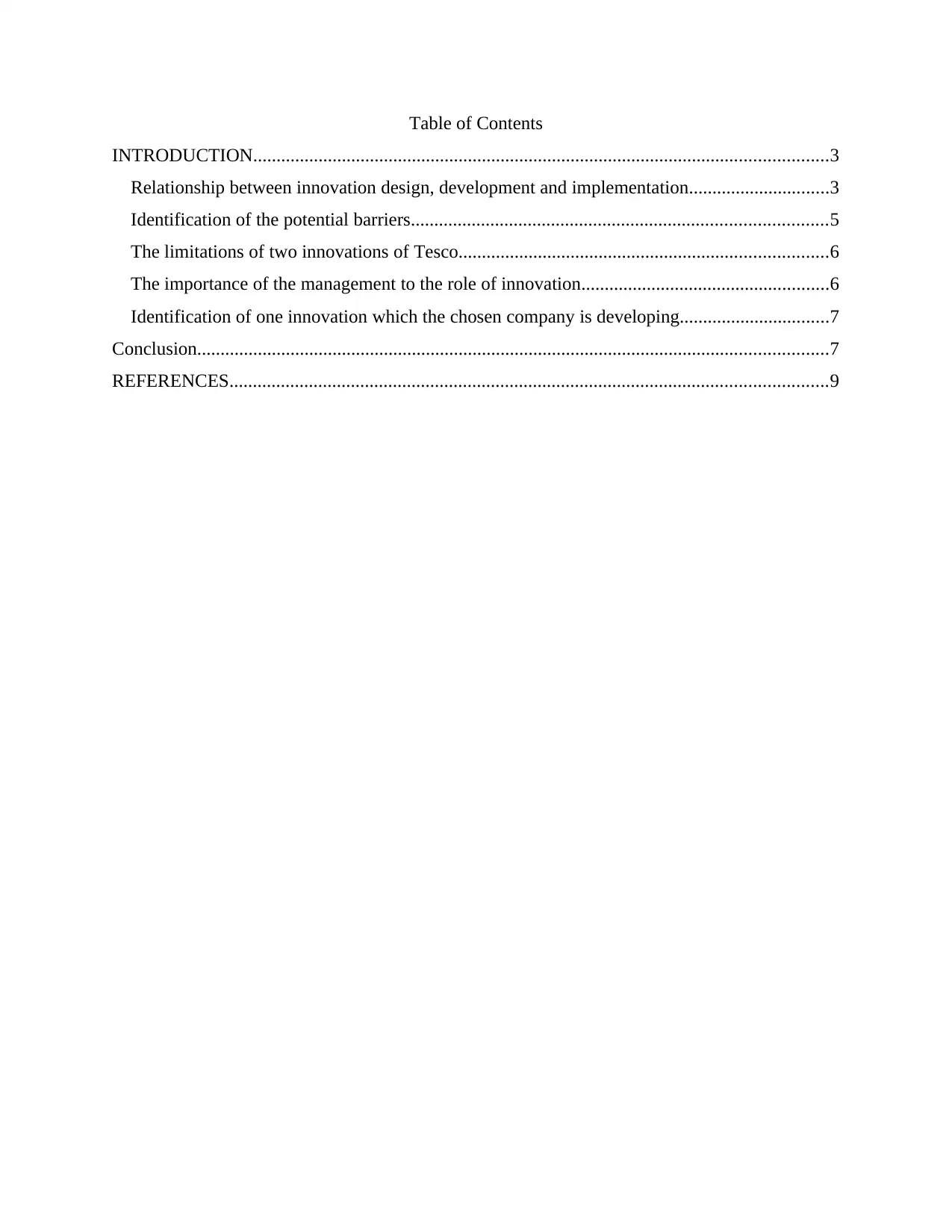
Table of Contents
INTRODUCTION...........................................................................................................................3
Relationship between innovation design, development and implementation..............................3
Identification of the potential barriers.........................................................................................5
The limitations of two innovations of Tesco...............................................................................6
The importance of the management to the role of innovation.....................................................6
Identification of one innovation which the chosen company is developing................................7
Conclusion.......................................................................................................................................7
REFERENCES................................................................................................................................9
INTRODUCTION...........................................................................................................................3
Relationship between innovation design, development and implementation..............................3
Identification of the potential barriers.........................................................................................5
The limitations of two innovations of Tesco...............................................................................6
The importance of the management to the role of innovation.....................................................6
Identification of one innovation which the chosen company is developing................................7
Conclusion.......................................................................................................................................7
REFERENCES................................................................................................................................9
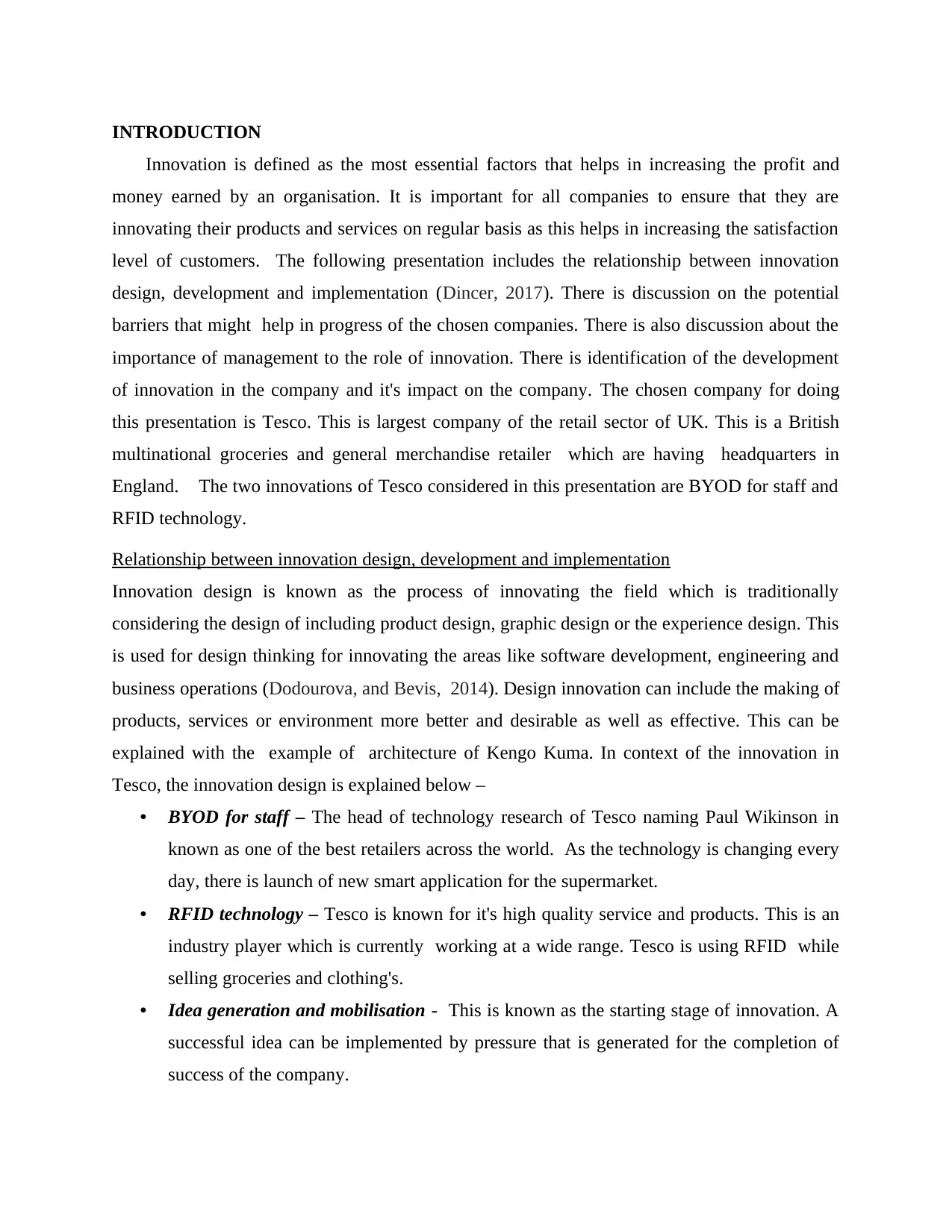
INTRODUCTION
Innovation is defined as the most essential factors that helps in increasing the profit and
money earned by an organisation. It is important for all companies to ensure that they are
innovating their products and services on regular basis as this helps in increasing the satisfaction
level of customers. The following presentation includes the relationship between innovation
design, development and implementation (Dincer, 2017). There is discussion on the potential
barriers that might help in progress of the chosen companies. There is also discussion about the
importance of management to the role of innovation. There is identification of the development
of innovation in the company and it's impact on the company. The chosen company for doing
this presentation is Tesco. This is largest company of the retail sector of UK. This is a British
multinational groceries and general merchandise retailer which are having headquarters in
England. The two innovations of Tesco considered in this presentation are BYOD for staff and
RFID technology.
Relationship between innovation design, development and implementation
Innovation design is known as the process of innovating the field which is traditionally
considering the design of including product design, graphic design or the experience design. This
is used for design thinking for innovating the areas like software development, engineering and
business operations (Dodourova, and Bevis, 2014). Design innovation can include the making of
products, services or environment more better and desirable as well as effective. This can be
explained with the example of architecture of Kengo Kuma. In context of the innovation in
Tesco, the innovation design is explained below –
• BYOD for staff – The head of technology research of Tesco naming Paul Wikinson in
known as one of the best retailers across the world. As the technology is changing every
day, there is launch of new smart application for the supermarket.
• RFID technology – Tesco is known for it's high quality service and products. This is an
industry player which is currently working at a wide range. Tesco is using RFID while
selling groceries and clothing's.
• Idea generation and mobilisation - This is known as the starting stage of innovation. A
successful idea can be implemented by pressure that is generated for the completion of
success of the company.
Innovation is defined as the most essential factors that helps in increasing the profit and
money earned by an organisation. It is important for all companies to ensure that they are
innovating their products and services on regular basis as this helps in increasing the satisfaction
level of customers. The following presentation includes the relationship between innovation
design, development and implementation (Dincer, 2017). There is discussion on the potential
barriers that might help in progress of the chosen companies. There is also discussion about the
importance of management to the role of innovation. There is identification of the development
of innovation in the company and it's impact on the company. The chosen company for doing
this presentation is Tesco. This is largest company of the retail sector of UK. This is a British
multinational groceries and general merchandise retailer which are having headquarters in
England. The two innovations of Tesco considered in this presentation are BYOD for staff and
RFID technology.
Relationship between innovation design, development and implementation
Innovation design is known as the process of innovating the field which is traditionally
considering the design of including product design, graphic design or the experience design. This
is used for design thinking for innovating the areas like software development, engineering and
business operations (Dodourova, and Bevis, 2014). Design innovation can include the making of
products, services or environment more better and desirable as well as effective. This can be
explained with the example of architecture of Kengo Kuma. In context of the innovation in
Tesco, the innovation design is explained below –
• BYOD for staff – The head of technology research of Tesco naming Paul Wikinson in
known as one of the best retailers across the world. As the technology is changing every
day, there is launch of new smart application for the supermarket.
• RFID technology – Tesco is known for it's high quality service and products. This is an
industry player which is currently working at a wide range. Tesco is using RFID while
selling groceries and clothing's.
• Idea generation and mobilisation - This is known as the starting stage of innovation. A
successful idea can be implemented by pressure that is generated for the completion of
success of the company.
⊘ This is a preview!⊘
Do you want full access?
Subscribe today to unlock all pages.

Trusted by 1+ million students worldwide
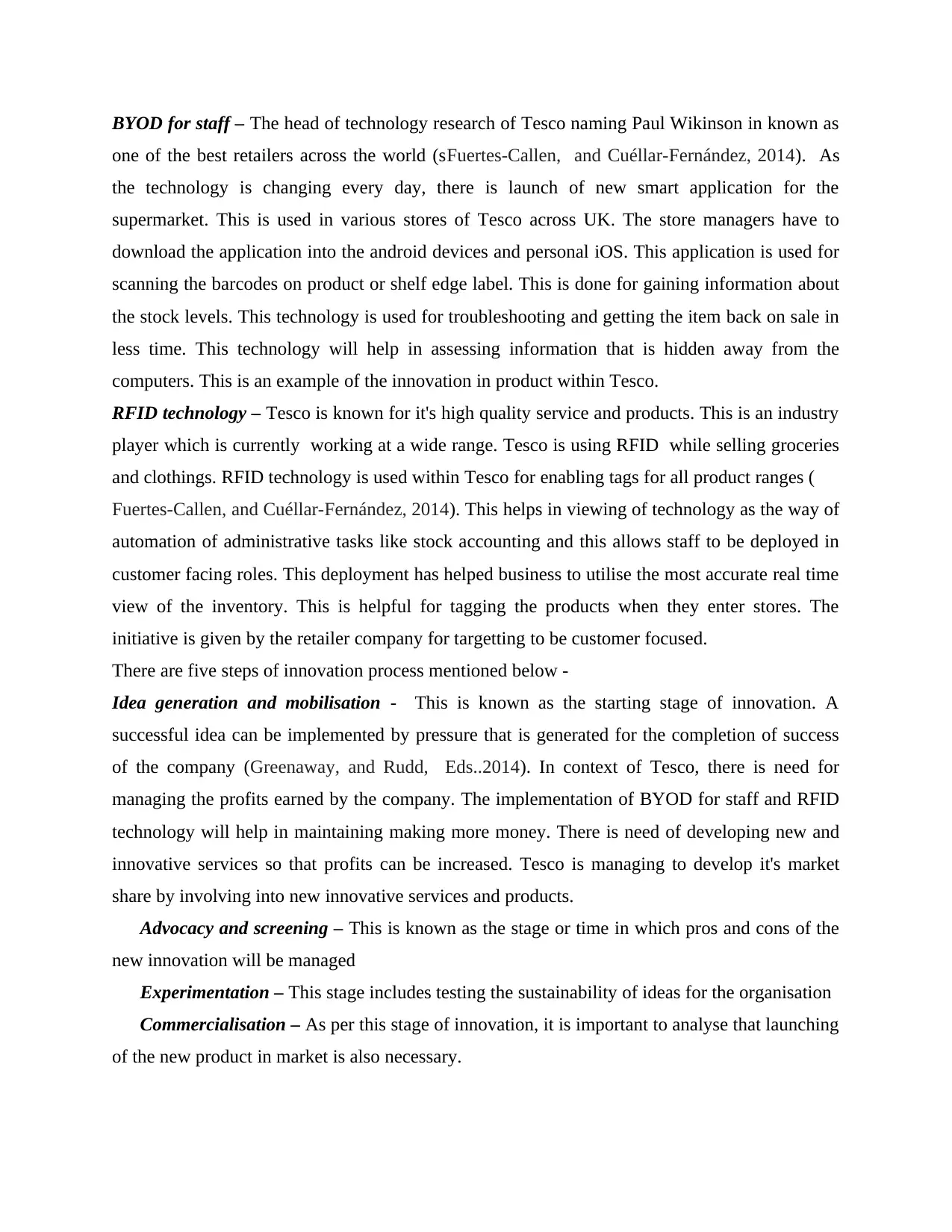
BYOD for staff – The head of technology research of Tesco naming Paul Wikinson in known as
one of the best retailers across the world (sFuertes-Callen, and Cuéllar-Fernández, 2014). As
the technology is changing every day, there is launch of new smart application for the
supermarket. This is used in various stores of Tesco across UK. The store managers have to
download the application into the android devices and personal iOS. This application is used for
scanning the barcodes on product or shelf edge label. This is done for gaining information about
the stock levels. This technology is used for troubleshooting and getting the item back on sale in
less time. This technology will help in assessing information that is hidden away from the
computers. This is an example of the innovation in product within Tesco.
RFID technology – Tesco is known for it's high quality service and products. This is an industry
player which is currently working at a wide range. Tesco is using RFID while selling groceries
and clothings. RFID technology is used within Tesco for enabling tags for all product ranges (
Fuertes-Callen, and Cuéllar-Fernández, 2014). This helps in viewing of technology as the way of
automation of administrative tasks like stock accounting and this allows staff to be deployed in
customer facing roles. This deployment has helped business to utilise the most accurate real time
view of the inventory. This is helpful for tagging the products when they enter stores. The
initiative is given by the retailer company for targetting to be customer focused.
There are five steps of innovation process mentioned below -
Idea generation and mobilisation - This is known as the starting stage of innovation. A
successful idea can be implemented by pressure that is generated for the completion of success
of the company (Greenaway, and Rudd, Eds..2014). In context of Tesco, there is need for
managing the profits earned by the company. The implementation of BYOD for staff and RFID
technology will help in maintaining making more money. There is need of developing new and
innovative services so that profits can be increased. Tesco is managing to develop it's market
share by involving into new innovative services and products.
Advocacy and screening – This is known as the stage or time in which pros and cons of the
new innovation will be managed
Experimentation – This stage includes testing the sustainability of ideas for the organisation
Commercialisation – As per this stage of innovation, it is important to analyse that launching
of the new product in market is also necessary.
one of the best retailers across the world (sFuertes-Callen, and Cuéllar-Fernández, 2014). As
the technology is changing every day, there is launch of new smart application for the
supermarket. This is used in various stores of Tesco across UK. The store managers have to
download the application into the android devices and personal iOS. This application is used for
scanning the barcodes on product or shelf edge label. This is done for gaining information about
the stock levels. This technology is used for troubleshooting and getting the item back on sale in
less time. This technology will help in assessing information that is hidden away from the
computers. This is an example of the innovation in product within Tesco.
RFID technology – Tesco is known for it's high quality service and products. This is an industry
player which is currently working at a wide range. Tesco is using RFID while selling groceries
and clothings. RFID technology is used within Tesco for enabling tags for all product ranges (
Fuertes-Callen, and Cuéllar-Fernández, 2014). This helps in viewing of technology as the way of
automation of administrative tasks like stock accounting and this allows staff to be deployed in
customer facing roles. This deployment has helped business to utilise the most accurate real time
view of the inventory. This is helpful for tagging the products when they enter stores. The
initiative is given by the retailer company for targetting to be customer focused.
There are five steps of innovation process mentioned below -
Idea generation and mobilisation - This is known as the starting stage of innovation. A
successful idea can be implemented by pressure that is generated for the completion of success
of the company (Greenaway, and Rudd, Eds..2014). In context of Tesco, there is need for
managing the profits earned by the company. The implementation of BYOD for staff and RFID
technology will help in maintaining making more money. There is need of developing new and
innovative services so that profits can be increased. Tesco is managing to develop it's market
share by involving into new innovative services and products.
Advocacy and screening – This is known as the stage or time in which pros and cons of the
new innovation will be managed
Experimentation – This stage includes testing the sustainability of ideas for the organisation
Commercialisation – As per this stage of innovation, it is important to analyse that launching
of the new product in market is also necessary.
Paraphrase This Document
Need a fresh take? Get an instant paraphrase of this document with our AI Paraphraser
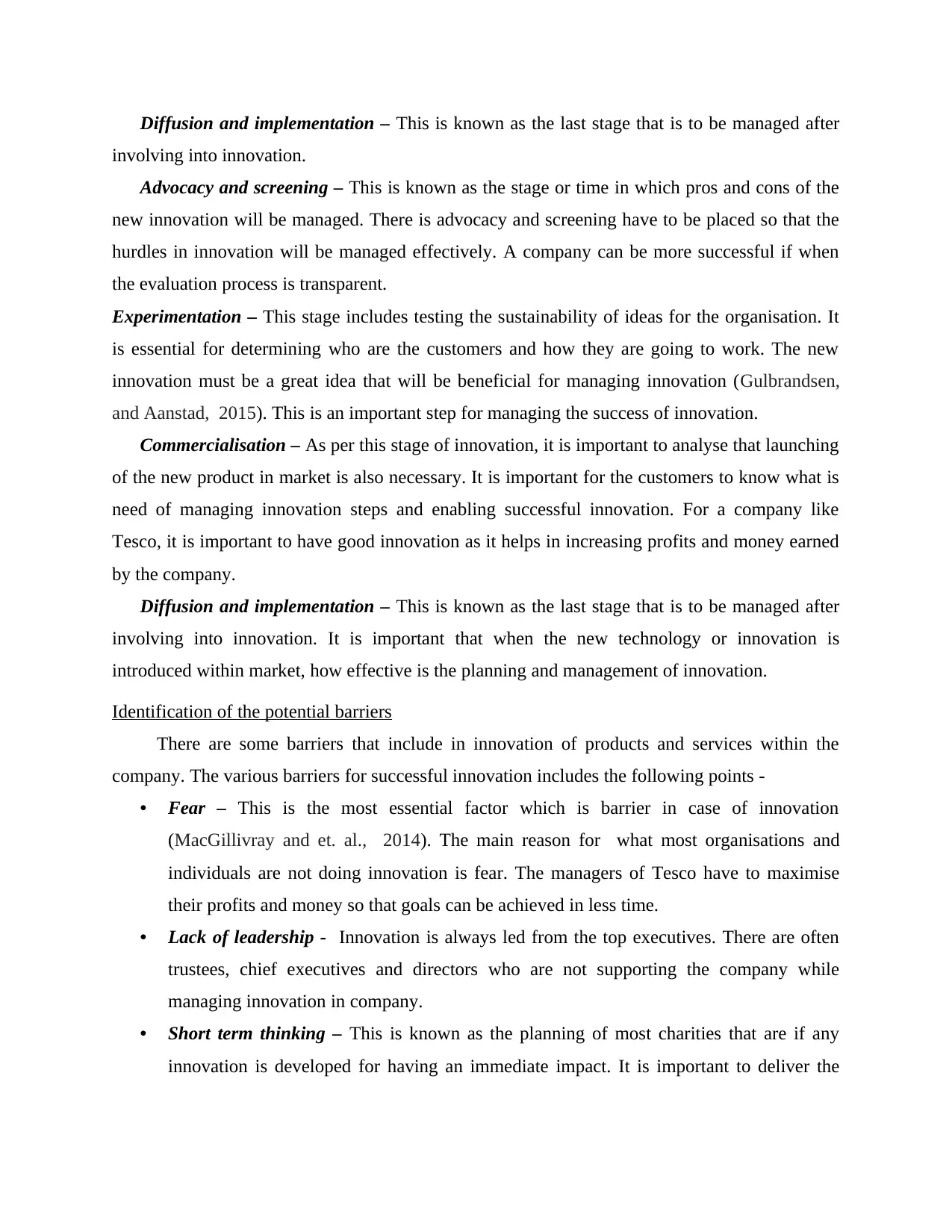
Diffusion and implementation – This is known as the last stage that is to be managed after
involving into innovation.
Advocacy and screening – This is known as the stage or time in which pros and cons of the
new innovation will be managed. There is advocacy and screening have to be placed so that the
hurdles in innovation will be managed effectively. A company can be more successful if when
the evaluation process is transparent.
Experimentation – This stage includes testing the sustainability of ideas for the organisation. It
is essential for determining who are the customers and how they are going to work. The new
innovation must be a great idea that will be beneficial for managing innovation (Gulbrandsen,
and Aanstad, 2015). This is an important step for managing the success of innovation.
Commercialisation – As per this stage of innovation, it is important to analyse that launching
of the new product in market is also necessary. It is important for the customers to know what is
need of managing innovation steps and enabling successful innovation. For a company like
Tesco, it is important to have good innovation as it helps in increasing profits and money earned
by the company.
Diffusion and implementation – This is known as the last stage that is to be managed after
involving into innovation. It is important that when the new technology or innovation is
introduced within market, how effective is the planning and management of innovation.
Identification of the potential barriers
There are some barriers that include in innovation of products and services within the
company. The various barriers for successful innovation includes the following points -
• Fear – This is the most essential factor which is barrier in case of innovation
(MacGillivray and et. al., 2014). The main reason for what most organisations and
individuals are not doing innovation is fear. The managers of Tesco have to maximise
their profits and money so that goals can be achieved in less time.
• Lack of leadership - Innovation is always led from the top executives. There are often
trustees, chief executives and directors who are not supporting the company while
managing innovation in company.
• Short term thinking – This is known as the planning of most charities that are if any
innovation is developed for having an immediate impact. It is important to deliver the
involving into innovation.
Advocacy and screening – This is known as the stage or time in which pros and cons of the
new innovation will be managed. There is advocacy and screening have to be placed so that the
hurdles in innovation will be managed effectively. A company can be more successful if when
the evaluation process is transparent.
Experimentation – This stage includes testing the sustainability of ideas for the organisation. It
is essential for determining who are the customers and how they are going to work. The new
innovation must be a great idea that will be beneficial for managing innovation (Gulbrandsen,
and Aanstad, 2015). This is an important step for managing the success of innovation.
Commercialisation – As per this stage of innovation, it is important to analyse that launching
of the new product in market is also necessary. It is important for the customers to know what is
need of managing innovation steps and enabling successful innovation. For a company like
Tesco, it is important to have good innovation as it helps in increasing profits and money earned
by the company.
Diffusion and implementation – This is known as the last stage that is to be managed after
involving into innovation. It is important that when the new technology or innovation is
introduced within market, how effective is the planning and management of innovation.
Identification of the potential barriers
There are some barriers that include in innovation of products and services within the
company. The various barriers for successful innovation includes the following points -
• Fear – This is the most essential factor which is barrier in case of innovation
(MacGillivray and et. al., 2014). The main reason for what most organisations and
individuals are not doing innovation is fear. The managers of Tesco have to maximise
their profits and money so that goals can be achieved in less time.
• Lack of leadership - Innovation is always led from the top executives. There are often
trustees, chief executives and directors who are not supporting the company while
managing innovation in company.
• Short term thinking – This is known as the planning of most charities that are if any
innovation is developed for having an immediate impact. It is important to deliver the
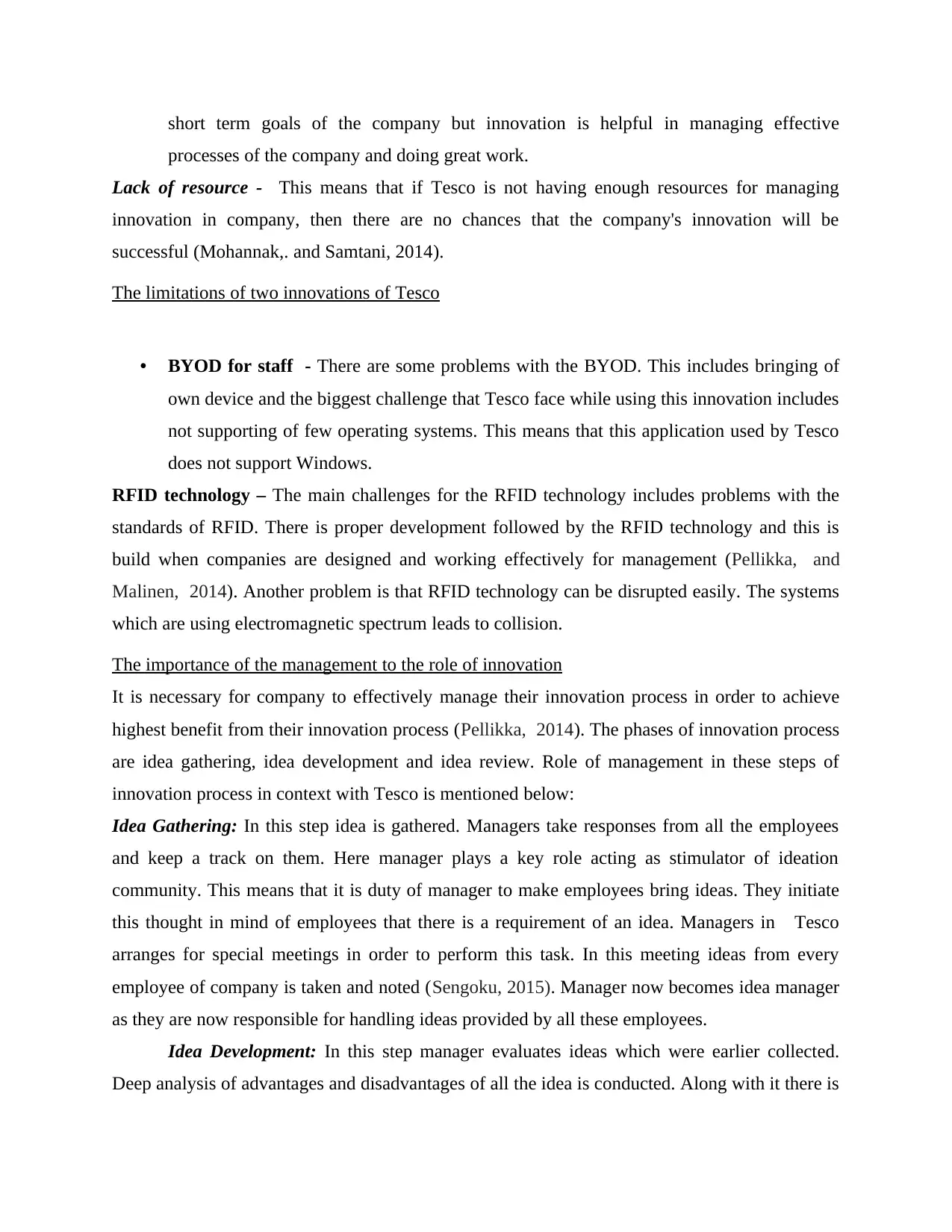
short term goals of the company but innovation is helpful in managing effective
processes of the company and doing great work.
Lack of resource - This means that if Tesco is not having enough resources for managing
innovation in company, then there are no chances that the company's innovation will be
successful (Mohannak,. and Samtani, 2014).
The limitations of two innovations of Tesco
• BYOD for staff - There are some problems with the BYOD. This includes bringing of
own device and the biggest challenge that Tesco face while using this innovation includes
not supporting of few operating systems. This means that this application used by Tesco
does not support Windows.
RFID technology – The main challenges for the RFID technology includes problems with the
standards of RFID. There is proper development followed by the RFID technology and this is
build when companies are designed and working effectively for management (Pellikka, and
Malinen, 2014). Another problem is that RFID technology can be disrupted easily. The systems
which are using electromagnetic spectrum leads to collision.
The importance of the management to the role of innovation
It is necessary for company to effectively manage their innovation process in order to achieve
highest benefit from their innovation process (Pellikka, 2014). The phases of innovation process
are idea gathering, idea development and idea review. Role of management in these steps of
innovation process in context with Tesco is mentioned below:
Idea Gathering: In this step idea is gathered. Managers take responses from all the employees
and keep a track on them. Here manager plays a key role acting as stimulator of ideation
community. This means that it is duty of manager to make employees bring ideas. They initiate
this thought in mind of employees that there is a requirement of an idea. Managers in Tesco
arranges for special meetings in order to perform this task. In this meeting ideas from every
employee of company is taken and noted (Sengoku, 2015). Manager now becomes idea manager
as they are now responsible for handling ideas provided by all these employees.
Idea Development: In this step manager evaluates ideas which were earlier collected.
Deep analysis of advantages and disadvantages of all the idea is conducted. Along with it there is
processes of the company and doing great work.
Lack of resource - This means that if Tesco is not having enough resources for managing
innovation in company, then there are no chances that the company's innovation will be
successful (Mohannak,. and Samtani, 2014).
The limitations of two innovations of Tesco
• BYOD for staff - There are some problems with the BYOD. This includes bringing of
own device and the biggest challenge that Tesco face while using this innovation includes
not supporting of few operating systems. This means that this application used by Tesco
does not support Windows.
RFID technology – The main challenges for the RFID technology includes problems with the
standards of RFID. There is proper development followed by the RFID technology and this is
build when companies are designed and working effectively for management (Pellikka, and
Malinen, 2014). Another problem is that RFID technology can be disrupted easily. The systems
which are using electromagnetic spectrum leads to collision.
The importance of the management to the role of innovation
It is necessary for company to effectively manage their innovation process in order to achieve
highest benefit from their innovation process (Pellikka, 2014). The phases of innovation process
are idea gathering, idea development and idea review. Role of management in these steps of
innovation process in context with Tesco is mentioned below:
Idea Gathering: In this step idea is gathered. Managers take responses from all the employees
and keep a track on them. Here manager plays a key role acting as stimulator of ideation
community. This means that it is duty of manager to make employees bring ideas. They initiate
this thought in mind of employees that there is a requirement of an idea. Managers in Tesco
arranges for special meetings in order to perform this task. In this meeting ideas from every
employee of company is taken and noted (Sengoku, 2015). Manager now becomes idea manager
as they are now responsible for handling ideas provided by all these employees.
Idea Development: In this step manager evaluates ideas which were earlier collected.
Deep analysis of advantages and disadvantages of all the idea is conducted. Along with it there is
⊘ This is a preview!⊘
Do you want full access?
Subscribe today to unlock all pages.

Trusted by 1+ million students worldwide
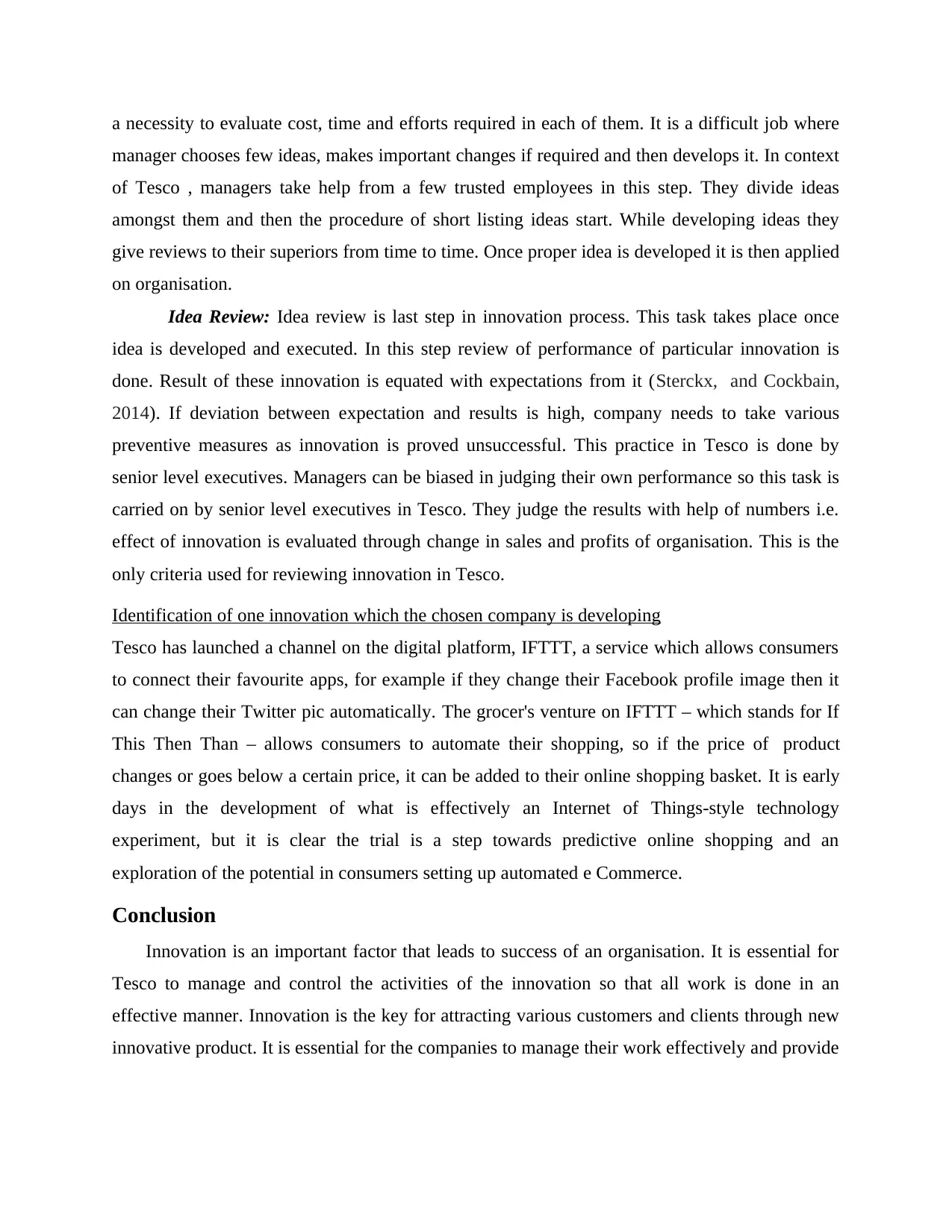
a necessity to evaluate cost, time and efforts required in each of them. It is a difficult job where
manager chooses few ideas, makes important changes if required and then develops it. In context
of Tesco , managers take help from a few trusted employees in this step. They divide ideas
amongst them and then the procedure of short listing ideas start. While developing ideas they
give reviews to their superiors from time to time. Once proper idea is developed it is then applied
on organisation.
Idea Review: Idea review is last step in innovation process. This task takes place once
idea is developed and executed. In this step review of performance of particular innovation is
done. Result of these innovation is equated with expectations from it (Sterckx, and Cockbain,
2014). If deviation between expectation and results is high, company needs to take various
preventive measures as innovation is proved unsuccessful. This practice in Tesco is done by
senior level executives. Managers can be biased in judging their own performance so this task is
carried on by senior level executives in Tesco. They judge the results with help of numbers i.e.
effect of innovation is evaluated through change in sales and profits of organisation. This is the
only criteria used for reviewing innovation in Tesco.
Identification of one innovation which the chosen company is developing
Tesco has launched a channel on the digital platform, IFTTT, a service which allows consumers
to connect their favourite apps, for example if they change their Facebook profile image then it
can change their Twitter pic automatically. The grocer's venture on IFTTT – which stands for If
This Then Than – allows consumers to automate their shopping, so if the price of product
changes or goes below a certain price, it can be added to their online shopping basket. It is early
days in the development of what is effectively an Internet of Things-style technology
experiment, but it is clear the trial is a step towards predictive online shopping and an
exploration of the potential in consumers setting up automated e Commerce.
Conclusion
Innovation is an important factor that leads to success of an organisation. It is essential for
Tesco to manage and control the activities of the innovation so that all work is done in an
effective manner. Innovation is the key for attracting various customers and clients through new
innovative product. It is essential for the companies to manage their work effectively and provide
manager chooses few ideas, makes important changes if required and then develops it. In context
of Tesco , managers take help from a few trusted employees in this step. They divide ideas
amongst them and then the procedure of short listing ideas start. While developing ideas they
give reviews to their superiors from time to time. Once proper idea is developed it is then applied
on organisation.
Idea Review: Idea review is last step in innovation process. This task takes place once
idea is developed and executed. In this step review of performance of particular innovation is
done. Result of these innovation is equated with expectations from it (Sterckx, and Cockbain,
2014). If deviation between expectation and results is high, company needs to take various
preventive measures as innovation is proved unsuccessful. This practice in Tesco is done by
senior level executives. Managers can be biased in judging their own performance so this task is
carried on by senior level executives in Tesco. They judge the results with help of numbers i.e.
effect of innovation is evaluated through change in sales and profits of organisation. This is the
only criteria used for reviewing innovation in Tesco.
Identification of one innovation which the chosen company is developing
Tesco has launched a channel on the digital platform, IFTTT, a service which allows consumers
to connect their favourite apps, for example if they change their Facebook profile image then it
can change their Twitter pic automatically. The grocer's venture on IFTTT – which stands for If
This Then Than – allows consumers to automate their shopping, so if the price of product
changes or goes below a certain price, it can be added to their online shopping basket. It is early
days in the development of what is effectively an Internet of Things-style technology
experiment, but it is clear the trial is a step towards predictive online shopping and an
exploration of the potential in consumers setting up automated e Commerce.
Conclusion
Innovation is an important factor that leads to success of an organisation. It is essential for
Tesco to manage and control the activities of the innovation so that all work is done in an
effective manner. Innovation is the key for attracting various customers and clients through new
innovative product. It is essential for the companies to manage their work effectively and provide
Paraphrase This Document
Need a fresh take? Get an instant paraphrase of this document with our AI Paraphraser

new innovative products within the company for enhancing the profits and money earned by the
company.
company.
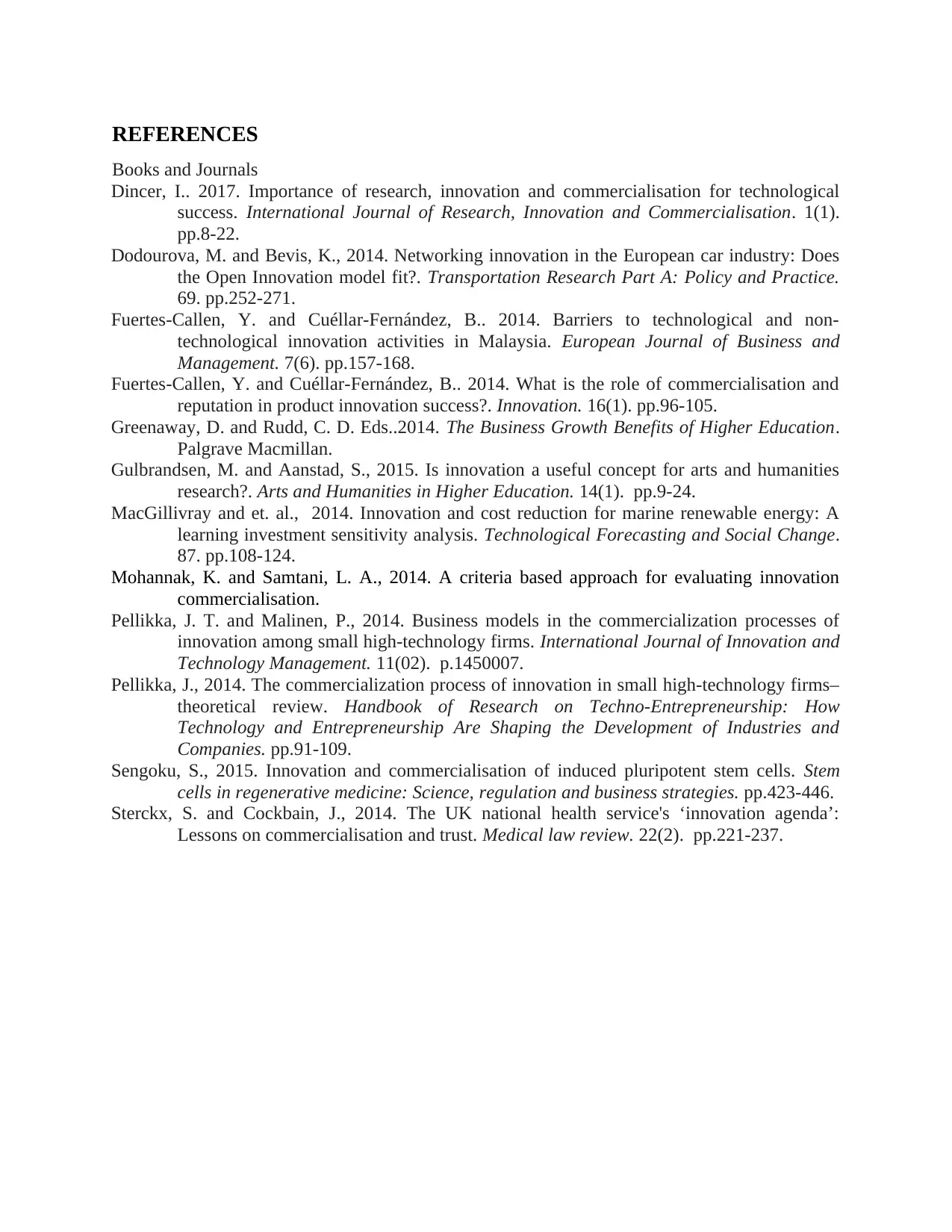
REFERENCES
Books and Journals
Dincer, I.. 2017. Importance of research, innovation and commercialisation for technological
success. International Journal of Research, Innovation and Commercialisation. 1(1).
pp.8-22.
Dodourova, M. and Bevis, K., 2014. Networking innovation in the European car industry: Does
the Open Innovation model fit?. Transportation Research Part A: Policy and Practice.
69. pp.252-271.
Fuertes-Callen, Y. and Cuéllar-Fernández, B.. 2014. Barriers to technological and non-
technological innovation activities in Malaysia. European Journal of Business and
Management. 7(6). pp.157-168.
Fuertes-Callen, Y. and Cuéllar-Fernández, B.. 2014. What is the role of commercialisation and
reputation in product innovation success?. Innovation. 16(1). pp.96-105.
Greenaway, D. and Rudd, C. D. Eds..2014. The Business Growth Benefits of Higher Education.
Palgrave Macmillan.
Gulbrandsen, M. and Aanstad, S., 2015. Is innovation a useful concept for arts and humanities
research?. Arts and Humanities in Higher Education. 14(1). pp.9-24.
MacGillivray and et. al., 2014. Innovation and cost reduction for marine renewable energy: A
learning investment sensitivity analysis. Technological Forecasting and Social Change.
87. pp.108-124.
Mohannak, K. and Samtani, L. A., 2014. A criteria based approach for evaluating innovation
commercialisation.
Pellikka, J. T. and Malinen, P., 2014. Business models in the commercialization processes of
innovation among small high-technology firms. International Journal of Innovation and
Technology Management. 11(02). p.1450007.
Pellikka, J., 2014. The commercialization process of innovation in small high-technology firms–
theoretical review. Handbook of Research on Techno-Entrepreneurship: How
Technology and Entrepreneurship Are Shaping the Development of Industries and
Companies. pp.91-109.
Sengoku, S., 2015. Innovation and commercialisation of induced pluripotent stem cells. Stem
cells in regenerative medicine: Science, regulation and business strategies. pp.423-446.
Sterckx, S. and Cockbain, J., 2014. The UK national health service's ‘innovation agenda’:
Lessons on commercialisation and trust. Medical law review. 22(2). pp.221-237.
Books and Journals
Dincer, I.. 2017. Importance of research, innovation and commercialisation for technological
success. International Journal of Research, Innovation and Commercialisation. 1(1).
pp.8-22.
Dodourova, M. and Bevis, K., 2014. Networking innovation in the European car industry: Does
the Open Innovation model fit?. Transportation Research Part A: Policy and Practice.
69. pp.252-271.
Fuertes-Callen, Y. and Cuéllar-Fernández, B.. 2014. Barriers to technological and non-
technological innovation activities in Malaysia. European Journal of Business and
Management. 7(6). pp.157-168.
Fuertes-Callen, Y. and Cuéllar-Fernández, B.. 2014. What is the role of commercialisation and
reputation in product innovation success?. Innovation. 16(1). pp.96-105.
Greenaway, D. and Rudd, C. D. Eds..2014. The Business Growth Benefits of Higher Education.
Palgrave Macmillan.
Gulbrandsen, M. and Aanstad, S., 2015. Is innovation a useful concept for arts and humanities
research?. Arts and Humanities in Higher Education. 14(1). pp.9-24.
MacGillivray and et. al., 2014. Innovation and cost reduction for marine renewable energy: A
learning investment sensitivity analysis. Technological Forecasting and Social Change.
87. pp.108-124.
Mohannak, K. and Samtani, L. A., 2014. A criteria based approach for evaluating innovation
commercialisation.
Pellikka, J. T. and Malinen, P., 2014. Business models in the commercialization processes of
innovation among small high-technology firms. International Journal of Innovation and
Technology Management. 11(02). p.1450007.
Pellikka, J., 2014. The commercialization process of innovation in small high-technology firms–
theoretical review. Handbook of Research on Techno-Entrepreneurship: How
Technology and Entrepreneurship Are Shaping the Development of Industries and
Companies. pp.91-109.
Sengoku, S., 2015. Innovation and commercialisation of induced pluripotent stem cells. Stem
cells in regenerative medicine: Science, regulation and business strategies. pp.423-446.
Sterckx, S. and Cockbain, J., 2014. The UK national health service's ‘innovation agenda’:
Lessons on commercialisation and trust. Medical law review. 22(2). pp.221-237.
⊘ This is a preview!⊘
Do you want full access?
Subscribe today to unlock all pages.

Trusted by 1+ million students worldwide
1 out of 9
Related Documents
Your All-in-One AI-Powered Toolkit for Academic Success.
+13062052269
info@desklib.com
Available 24*7 on WhatsApp / Email
![[object Object]](/_next/static/media/star-bottom.7253800d.svg)
Unlock your academic potential
Copyright © 2020–2025 A2Z Services. All Rights Reserved. Developed and managed by ZUCOL.




